Electricity generation

| Part ofa serieson |
| Power engineering |
|---|
| Electric power conversion |
| Electric power infrastructure |
| Electric power systems components |
Electricity generationis the process of generatingelectric powerfrom sources ofprimary energy.Forutilitiesin theelectric power industry,it is the stage prior to itsdelivery(transmission,distribution,etc.) to end users or itsstorage,using for example, thepumped-storagemethod.
Usable electricity is not freely available in nature, so it must be "produced", transforming other forms of energy to electricity. Production is carried out inpower stations,also called "power plants". Electricity is most often generated at a power plant byelectromechanicalgenerators,primarily driven byheat enginesfueled bycombustionornuclear fission,but also by other means such as thekinetic energyof flowing water and wind. Other energy sources include solarphotovoltaicsandgeothermal power.There are exotic and speculative methods to recover energy, such as proposedfusion reactordesigns which aim to directly extract energy from intense magnetic fields generated by fast-moving charged particles generated by the fusion reaction (seemagnetohydrodynamics).
Phasing out coal-fired power stationsand eventuallygas-fired power stations,[1]or, if practical,capturing their greenhouse gas emissions,is an important part of theenergy transformationrequired tolimit climate change.Vastly moresolar power[2]andwind power[3]is forecast to be required, withelectricity demandincreasing strongly[4]with furtherelectrificationoftransport,homes and industry.[5]However, in 2023, it was reported that the global electricity supply was approaching peak CO2 emissions thanks to the growth of solar and wind power.[6]
History[edit]
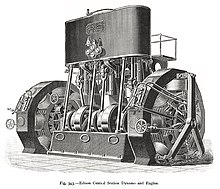
The fundamental principles of electricity generation were discovered in the 1820s and early 1830s by British scientistMichael Faraday.His method, still used today, is for electricity to be generated by the movement of a loop of wire, orFaraday disc,between the poles of amagnet.Central power stations became economically practical with the development ofalternating current(AC) power transmission, using powertransformersto transmit power at high voltage and with low loss.
Commercial electricity production started with the coupling of the dynamo to the hydraulic turbine. The mechanical production of electric power began theSecond Industrial Revolutionand made possible several inventions using electricity, with the major contributors beingThomas Alva EdisonandNikola Tesla.Previously the only way to produce electricity was by chemical reactions or using battery cells, and the only practical use of electricity was for thetelegraph.
Electricity generation at central power stations started in 1882, when asteam enginedriving a dynamo atPearl Street Stationproduced aDC currentthat powered public lighting onPearl Street,New York.The new technology was quickly adopted by many cities around the world, which adapted their gas-fueled street lights to electric power. Soon after electric lights would be used in public buildings, in businesses, and to power public transport, such as trams and trains.
The first power plants used water power or coal.[7]Today a variety of energy sources are used, such ascoal,nuclear,natural gas,hydroelectric,wind,andoil,as well assolar energy,tidal power,andgeothermalsources.
In the 1880s the popularity of electricity grew massively with the introduction of theIncandescent light bulb.Although there are 22 recognised inventors of the light bulb prior toJoseph SwanandThomas Edison,Edison and Swan's invention became by far the most successful and popular of all. During the early years of the 19th century, massive jumps inelectrical scienceswere made. And by the later 19th century the advancement of electrical technology and engineering led to electricity being part of everyday life. With the introduction of many electrical inventions and their implementation into everyday life, the demand for electricity within homes grew dramatically. With this increase in demand, the potential for profit was seen by many entrepreneurs who began investing into electrical systems to eventually create the first electricity public utilities. This process in history is often described as electrification.[8]
The earliest distribution of electricity came from companies operating independently of one another. A consumer would purchase electricity from a producer, and the producer would distribute it through their own power grid. As technology improved so did the productivity and efficiency of its generation. Inventions such as thesteam turbinehad a massive impact on the efficiency of electrical generation but also the economics of generation as well. This conversion of heat energy into mechanical work was similar to that ofsteam engines,however at a significantly larger scale and far more productively. The improvements of these large-scale generation plants were critical to the process of centralised generation as they would become vital to the entire power system that we now use today.
Throughout the middle of the 20th century many utilities began merging theirdistribution networksdue to economic and efficiency benefits. Along with the invention of long-distancepower transmission,the coordination of power plants began to form. This system was then secured by regional system operators to ensure stability and reliability. The electrification of homes began in Northern Europe and in the Northern America in the 1920s in large cities and urban areas. It was not until the 1930s that rural areas saw the large-scale establishment of electrification.[9]
Methods of generation[edit]
2021world electricity generationby source. Total generation was 28petawatt-hours.[10]
Several fundamental methods exist to convert other forms of energy into electrical energy. Utility-scale generation is achieved by rotatingelectric generatorsor byphotovoltaicsystems. A small proportion of electric power distributed by utilities is provided by batteries. Other forms of electricity generation used in niche applications include thetriboelectric effect,thepiezoelectric effect,thethermoelectric effect,andbetavoltaics.
Generators[edit]
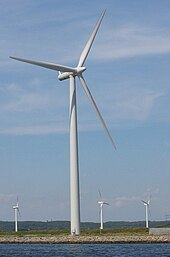
Electric generatorstransformkinetic energyinto electricity. This is the most used form for generating electricity and is based onFaraday's law.It can be seen experimentally by rotating a magnet within closed loops of conducting material, e.g. copper wire. Almost all commercial electrical generation is done using electromagnetic induction, in whichmechanical energyforces a generator to rotate.
Electrochemistry[edit]
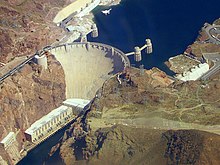
Electrochemistryis the direct transformation ofchemical energyinto electricity, as in abattery.Electrochemical electricity generation is important in portable and mobile applications. Currently, most electrochemical power comes from batteries.[11]Primary cells,such as the commonzinc–carbon batteries,act as power sources directly, butsecondary cells(i.e. rechargeable batteries) are used forstoragesystems rather than primary generation systems. Open electrochemical systems, known asfuel cells,can be used to extract power either from natural fuels or from synthesized fuels.Osmotic poweris a possibility at places where salt and fresh water merge.
Photovoltaic effect[edit]
Thephotovoltaic effectis the transformation of light into electrical energy, as insolar cells.Photovoltaic panelsconvert sunlight directly to DC electricity.Power inverterscan then convert that to AC electricity if needed. Although sunlight is free and abundant,solar powerelectricity is still usually more expensive to produce than large-scale mechanically generated power due to the cost of the panels.[citation needed]Low-efficiency silicon solar cells have been decreasing in cost and multijunction cells with close to 30% conversion efficiency are now commercially available. Over 40% efficiency has been demonstrated in experimental systems.[12]
Until recently, photovoltaics were most commonly used in remote sites where there is no access to a commercial power grid, or as a supplemental electricity source for individual homes and businesses. Recent advances in manufacturing efficiency and photovoltaic technology, combined with subsidies driven by environmental concerns, have dramatically accelerated the deployment of solar panels. Installed capacity is growing by around 20% per year[2]led by increases in Germany, Japan, United States, China, and India.
Economics[edit]
The selection of electricity production modes and their economic viability varies in accordance with demand and region. The economics vary considerably around the world, resulting in widespread residential selling prices.Hydroelectric plants,nuclear power plants,thermal power plantsandrenewable sourceshave their own pros and cons, and selection is based upon the local power requirement and the fluctuations in demand.
All power grids have varying loads on them. The daily minimum[citation needed]is thebase load,often supplied by plants which run continuously. Nuclear, coal, oil, gas and some hydro plants can supply base load. If well construction costs for natural gas are below $10 per MWh, generating electricity from natural gas is cheaper than generating power by burning coal.[13]
Nuclear power plants can produce a huge amount of power from a single unit. However, nuclear disasters have raised concerns over the safety of nuclear power, and the capital cost of nuclear plants is very high. Hydroelectric power plants are located in areas where the potential energy from falling water can be harnessed for moving turbines and the generation of power. It may not be an economically viable single source of production where the ability to store the flow of water is limited and the load varies too much during the annual production cycle.
Generating equipment[edit]

Electric generators were known in simple forms from the discovery ofelectromagnetic inductionin the 1830s. In general, some form of prime mover such as an engine or the turbines described above, drives a rotating magnetic field past stationary coils of wire thereby turning mechanical energy into electricity.[14]The only commercial scale forms of electricity production that do not employ a generator arephotovoltaic solarandfuel cells.
Turbines[edit]
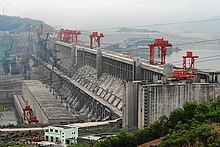
Almost all commercial electrical power on Earth is generated with aturbine,driven by wind, water, steam or burning gas. The turbine drives a generator, thus transforming its mechanical energy into electrical energy by electromagnetic induction. There are many different methods of developing mechanical energy, includingheat engines,hydro, wind and tidal power. Most electric generation is driven by heat engines.
The combustion offossil fuelssupplies most of the energy to these engines, with a significant fraction fromnuclear fissionand some fromrenewable sources.The modernsteam turbine,invented bySir Charles Parsonsin 1884, currently generates about 80% of theelectric powerin the world using a variety of heat sources. Turbine types include:
- Steam
- Water is boiled bycoalburned in athermal power plant.About 41% of all electricity is generated this way.[15]
- Nuclear fissionheat created in anuclear reactorcreates steam. Less than 15% of electricity is generated this way.
- Renewable energy. The steam is generated bybiomass,solar thermal energy,orgeothermal power.
- Natural gas: turbines are driven directly by gases produced by combustion.Combined cycleare driven by both steam and natural gas. They generate power by burning natural gas in agas turbineand use residual heat to generate steam. At least 20% of the world's electricity is generated by natural gas.
- Water Energy is captured by awater turbinefrom the movement of water - from falling water, the rise and fall of tides or ocean thermal currents (seeocean thermal energy conversion). Currently, hydroelectric plants provide approximately 16% of the world's electricity.
- Thewindmillwas a very earlywind turbine.In 2018 around 5% of the world's electricity was produced from wind
Turbines can also use other heat-transfer liquids than steam.Supercritical carbon dioxidebased cycles can provide higher conversion efficiency due to faster heat exchange, higher energy density and simpler power cycle infrastructure.Supercritical carbon dioxide blends,that are currently in development, can further increase efficiency by optimizing its critical pressure and temperature points.
Although turbines are most common in commercial power generation, smaller generators can be powered bygasolineordiesel engines.These may used for backup generation or as a prime source of power within isolated villages.
World production[edit]

Total world generation in 2021 was 28,003 TWh, including coal (36%), gas (23%), hydro (15%), nuclear (10%), wind (6.6%), solar (3.7%), oil and other fossil fuels (3.1%), biomass (2.4%) and geothermal and other renewables (0.33%).[10]
Production by country[edit]
China produced a third of the world's electricity in 2021, largely from coal. The United States produces half as much as China but uses far more natural gas and nuclear.[10]
Environmental concerns[edit]
Variations between countries generating electrical power affect concerns about the environment. In France only 10% of electricity is generated fromfossil fuels,the US is higher at 70% and China is at 80%.[16]The cleanliness of electricity depends on its source.Methane leaks(from natural gas to fuel gas-fired power plants)[17]andcarbon dioxide emissionsfrom fossil fuel-based electricity generation account for a significant portion of worldgreenhouse gas emissions.[18]In the United States, fossil fuel combustion for electric power generation is responsible for 65% of all emissions ofsulfur dioxide,the main component of acid rain.[19]Electricity generation is the fourth highest combined source ofNOx,carbon monoxide,andparticulate matterin the US.[20]
According to theInternational Energy Agency(IEA), low-carbon electricity generation needs to account for 85% of global electrical output by 2040 in order to ward off the worst effects of climate change.[21]Like other organizations including theEnergy Impact Center(EIC)[22]and theUnited Nations Economic Commission for Europe(UNECE),[23]the IEA has called for the expansion of nuclear and renewable energy to meet that objective.[24]Some, like EIC founder Bret Kugelmass, believe that nuclear power is the primary method fordecarbonizingelectricity generation because it can also powerdirect air capturethat removes existing carbon emissions from the atmosphere.[25]Nuclear power plants can also createdistrict heatinganddesalinationprojects, limiting carbon emissions and the need for expanded electrical output.[26]
A fundamental issue regarding centralised generation and the current electrical generation methods in use today is the significant negative environmental effects that many of the generation processes have. Processes such as coal and gas not only release carbon dioxide as they combust, but their extraction from the ground also impacts the environment. Open pit coal mines use large areas of land to extract coal and limit the potential for productive land use after the excavation. Natural gas extraction releases large amounts of methane into the atmosphere when extracted from the ground greatly increase global greenhouse gases. Although nuclear power plants do not release carbon dioxide through electricity generation, there are risks associated with nuclear waste and safety concerns associated with the use of nuclear sources.
Per unit of electricity generated coal and gas-fired powerlife-cycle greenhouse gas emissionsare almost always at least ten times that of other generation methods.[27]
Centralised and distributed generation[edit]
Centralised generation is electricity generation by large-scale centralised facilities, sent throughtransmission linesto consumers. These facilities are usually located far away from consumers and distribute the electricity through high voltage transmission lines to a substation, where it is then distributed to consumers; the basic concept being that multi-megawatt or gigawatt scale large stations create electricity for a large number of people. The vast majority of electricity used is created from centralised generation. Most centralised power generation comes from large power plants run by fossil fuels such as coal or natural gas, though nuclear or large hydroelectricity plants are also commonly used.[28]
Centralised generation is fundamentally the opposite ofdistributed generation.Distributed generation is the small-scale generation of electricity to smaller groups of consumers. This can also include independently producing electricity by either solar or wind power. In recent years distributed generation as has seen a spark in popularity due to its propensity to userenewable energygeneration methods such asrooftop solar.[29]
Technologies[edit]
Centralised energy sources are largepower plantsthat produce huge amounts of electricity to a large number of consumers. Most power plants used in centralised generation arethermal power plantsmeaning that they use a fuel to heat steam to produce a pressurised gas which in turn spins a turbine and generates electricity. This is the traditional way of producing energy. This process relies on several forms of technology to produce widespread electricity, these being natural coal, gas and nuclear forms of thermal generation. More recently solar and wind have become large scale.
Solar[edit]

Aphotovoltaic power station,also known as a solar park, solar farm, or solar power plant, is a large-scalegrid-connected photovoltaic power system(PV system) designed for the supply ofmerchant power.They are different from most building-mounted and other decentralizedsolar powerbecause they supply power at theutilitylevel, rather than to a local user or users. Utility-scale solar is sometimes used to describe this type of project.
This approach differs fromconcentrated solar power,the other major large-scale solar generation technology, which uses heat to drive a variety of conventional generator systems. Both approaches have their own advantages and disadvantages, but to date, for a variety of reasons,photovoltaictechnology has seen much wider use. As of 2019[update],about 97% of utility-scale solar power capacity was PV.[30][31]
In some countries, thenameplate capacityof photovoltaic power stations is rated inmegawatt-peak(MWp), which refers to the solar array's theoretical maximumDCpower output. In other countries, the manufacturer states the surface and the efficiency. However, Canada, Japan, Spain, and the United States often specify using the converted lower nominal power output inMWAC,a measure more directly comparable to other forms of power generation. Most solar parks are developed at a scale of at least 1 MWp.As of 2018, theworld's largestoperating photovoltaic power stations surpassed 1gigawatt.At the end of 2019, about 9,000 solar farms were larger than 4 MWAC(utility scale), with a combined capacity of over 220 GWAC.[30]
Most of the existing large-scale photovoltaic power stations are owned and operated byindependent power producers,but the involvement of community and utility-owned projects is increasing.[32]Previously, almost all were supported at least in part by regulatory incentives such asfeed-in tariffsortax credits,but aslevelized costsfell significantly in the 2010s andgrid parityhas been reached in most markets, external incentives are usually not needed.Wind[edit]


Awind farmor wind park, also called a wind power station or wind power plant,[33]is a group ofwind turbinesin the same location usedto produce electricity.Wind farms vary in size from a small number of turbines to several hundred wind turbines covering an extensive area. Wind farms can be either onshore oroffshore.
Many of the largest operational onshore wind farms are located in China, India, and the United States. For example, thelargest wind farm in the world,Gansu Wind Farmin China had a capacity of over 6,000MWby 2012,[34]with a goal of 20,000 MW[35]by 2020.[36]As of December 2020, the 1218 MWHornsea Wind Farmin the UK isthe largest offshore wind farm in the world.[37]Individual wind turbine designs continue toincrease in power,resulting in fewer turbines being needed for the same total output.
Because they require no fuel, wind farms have less impact on the environment than many other forms of power generation and are often referred to as a good source ofgreen energy.Wind farms have, however, been criticised for their visual impact and impact on the landscape. Typically they need to be spread over more land than other power stations and need to be built in wild and rural areas, which can lead to "industrialization of the countryside",habitat loss,and a drop in tourism. Some critics claim that wind farms have adverse health effects, but most researchers consider these claims to be pseudoscience (seewind turbine syndrome). Wind farms can interfere with radar, although in most cases, according to the US Department of Energy, "siting and other mitigations have resolved conflicts and allowed wind projects to co-exist effectively with radar".[38]Coal[edit]


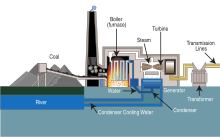
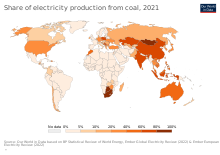
Acoal-fired power stationor coal power plant is athermal power stationwhich burnscoalto generateelectricity.Worldwide there are over 2,400 coal-fired power stations, totaling over 2,130gigawattscapacity.[39]They generate about a third of theworld's electricity,[40]but cause many illnesses and the most early deaths,[41]mainly fromair pollution.[42][43]World installed capacity doubled from 2000 to 2023 and increased 2% in 2023.[44]
A coal-fired power station is a type offossil fuel power station.The coal is usuallypulverizedand then burned in apulverized coal-fired boiler.The furnace heat converts boiler water tosteam,which is then used to spinturbinesthat turngenerators.Thus chemical energy stored in coal is converted successively intothermal energy,mechanical energyand, finally,electrical energy.
Coal-fired power stations emit over 10 billion tonnes ofcarbon dioxideeach year,[45]about one fifth of worldgreenhouse gas emissions,so are the single largestcause of climate change.[46]More than half of all the coal-fired electricity in the world is generated in China.[47]In 2020 the total number of plants started falling[48][49]as they are being retired in Europe[50]and America[51]although still being built in Asia, almost all in China.[52]Some remain profitable becausecosts to other peopledue to thehealth and environmental impact of the coal industryare not priced into the cost of generation,[53][54]but there is the risk newer plants may becomestranded assets.[55]TheUN Secretary Generalhas said thatOECDcountries shouldstop generating electricity from coalby 2030, and the rest of the world by 2040.[56]Vietnam is among the few coal-dependent fast developing countries that fully pledged to phase out unbated coal power by the 2040s or as soon as possible thereafter.[57]Natural gas[edit]
Natural gas is ignited to create pressurised gas which is used to spin turbines to generate electricity. Natural gas plants use agas turbinewhere natural gas is added along with oxygen which in turn combusts and expands through the turbine to force a generator to spin.
Natural gas power plantsare more efficient than coal power generation, they however contribute to climate change, but not as highly as coal generation. Not only do they produce carbon dioxide from the ignition of natural gas, the extraction of gas when mined releases a significant amount ofmethaneinto the atmosphere.[58]
Nuclear[edit]
Nuclear power plantscreate electricity through steam turbines where the heat input is from the process ofnuclear fission.Currently, nuclear power produces 11% of all electricity in the world. Most nuclear reactors useuraniumas a source of fuel. In a process callednuclear fission,energy, in the form of heat, is released when nuclear atoms are split. Electricity is created through the use of a nuclear reactor where heat produced by nuclear fission is used to produce steam which in turn spins turbines and powers the generators. Although there are several types of nuclear reactors, all fundamentally use this process.[59]
Normal emissions due to nuclear power plants are primarily waste heat and radioactive spent fuel. In a reactor accident, significant amounts of radioisotopes can be released to the environment, posing a long term hazard to life. This hazard has been a continuing concern of environmentalists. Accidents such as theThree Mile Island accident,Chernobyl disasterand theFukushima nuclear disasterillustrate this problem.[60]
Electricity generation capacity by country[edit]
The table lists 45 countries with their total electricity capacities. The data is from 2022. According to theEnergy Information Administration,the total global electricity capacity in 2022 was nearly 8.9terawatt(TW), more than four times the total global electricity capacity in 1981. The global average per-capita electricity capacity was about 1,120wattsin 2022, nearly two and a half times the global average per-capita electricity capacity in 1981.
Icelandhas the highest installed capacity per capita in the world, at about 8,990 watts. All developed countries have an average per-capita electricity capacity above the global average per-capita electricity capacity, with theUnited Kingdomhaving the lowest average per-capita electricity capacity of all other developed countries.
| Country | Total capacity (GW) |
Average per capita capacity (watts) |
|---|---|---|
| World | 8,890 | 1,120 |
| 2,510 | 1,740 | |
| 1,330 | 3,940 | |
| 1,080 | 2,420 | |
| 556 | 397 | |
| 370 | 2,940 | |
| 296 | 2,030 | |
| 267 | 3,220 | |
| 222 | 1,030 | |
| 167 | 4,460 | |
| 160 | 3,130 | |
| 148 | 2,280 | |
| 133 | 2,230 | |
| 119 | 2,580 | |
| 111 | 1,640 | |
| 107 | 1,240 | |
| 104 | 792 | |
| 95.8 | 3,680 | |
| 85.3 | 2,380 | |
| 83.3 | 977 | |
| 72.2 | 721 | |
| 66.7 | 1,100 | |
| 64 | 1,690 | |
| 63 | 901 | |
| 62.2 | 1,440 | |
| 61.1 | 582 | |
| 58 | 2,440 | |
| 53.3 | 3,010 | |
| 52.1 | 5,100 | |
| 51.9 | 1,130 | |
| 42.7 | 192 | |
| 41.7 | 7,530 | |
| 40.7 | 4,010 | |
| 37.9 | 1,110 | |
| 37 | 1,930 | |
| 34.1 | 1,210 | |
| 29.6 | 1,600 | |
| 27.8 | 2,960 | |
| 26.7 | 2,890 | |
| 25.9 | 590 | |
| 24.4 | 2,400 | |
| 23.7 | 2,520 | |
| 22.2 | 3,980 | |
| 21.3 | 3,710 | |
| 13.3 | 2,420 | |
| 11.6 | 2,320 | |
| 3.24 | 8,990 |
See also[edit]
- Glossary of power generation
- Cogeneration:the use of a heat engine or power station to generate electricity and useful heat at the same time.
- Cost of electricity by source
- Diesel generator
- Engine-generator
- Generation expansion planning
- Steam-electric power station
- World energy supply and consumption
References[edit]
- ^Chestney, Nina (2021-05-14)."Factbox: Getting out of gas - the sold and scrapped projects".Reuters.Archivedfrom the original on 2021-11-27.Retrieved2021-11-27.
- ^ab"Solar PV – Analysis".IEA.Archivedfrom the original on 2021-11-27.Retrieved2021-11-27.
- ^"What would a world powered entirely by offshore wind look like?".The Economist.2021-11-04.ISSN0013-0613.Archivedfrom the original on 2021-11-26.Retrieved2021-11-27.
- ^"Electricity – Global Energy Review 2021 – Analysis".IEA.April 2021.Archivedfrom the original on 2021-11-27.Retrieved2021-11-27.
- ^Shadbolt, Rory (26 Nov 2021)."Accelerated renewables-based electrification for the future".SelectScience.Archivedfrom the original on 2021-11-27.Retrieved2021-11-27.
- ^Lempriere, Molly (2023-10-04)."World's electricity supply close to 'peak emissions' due to growth of wind and solar".Carbon Brief.Retrieved2023-11-08.
- ^"Pearl Street Station - Engineering and Technology History Wiki".ethw.org.Archivedfrom the original on 2016-08-26.Retrieved2016-08-14.
- ^"History of Electrification Sites".edisontechcenter.org.Archivedfrom the original on 25 May 2019.Retrieved8 June2019.
- ^"Power Grid History".www.itc-holdings.com.Archivedfrom the original on 8 June 2019.Retrieved8 June2019.
- ^abcd"Yearly electricity data".ember-climate.org.6 Dec 2023.Retrieved23 Dec2023.
- ^World's Largest Utility Battery System Installed in AlaskaArchived2008-06-27 at theWayback Machine(press release, 2003-09-24), U.S. Department of Energy."13,670 nickel-cadmium battery cells to generate up to 40 megawatts of power for about 7 minutes, or 27 megawatts of power for 15 minutes."
- ^New World Record Achieved in Solar Cell TechnologyArchived2007-04-23 at theWayback Machine(press release, 2006-12-05), U.S. Department of Energy.
- ^Smith, Karl (22 March 2013)."Will Natural Gas Stay Cheap Enough To Replace Coal And Lower Us Carbon Emissions".Forbes.Archivedfrom the original on 2 November 2017.Retrieved20 June2015.
- ^Sedlazeck, K.; Richter, C.; Strack, S.; Lindholm, S.; Pipkin, J.; Fu, F.; Humphries, B.; Montgomery, L. (May 1, 2009). "Type testing a 2000 MW turbogenerator".2009 IEEE International Electric Machines and Drives Conference.pp. 465–470.doi:10.1109/IEMDC.2009.5075247.ISBN978-1-4244-4251-5.S2CID9118902– via IEEE Xplore.
- ^"Coal & electricity".World Coal Association.2015-04-29.Archivedfrom the original on 2016-08-23.Retrieved2016-08-14.
- ^"Statistics and Balances".IEA.Archived fromthe originalon 15 May 2011.Retrieved12 July2011.
- ^Patrick Pester (2022-02-10)."Massive methane leaks mapped from space".Live Science.Archivedfrom the original on 2022-06-29.Retrieved2022-06-29.
- ^Borenstein, Seth (2007-06-03)."Carbon-emissions culprit? Coal".The Seattle Times.Archived fromthe originalon 2011-04-24.
- ^"Sulfur Dioxide".US Environmental Protection Agency. 16 November 2016.Archivedfrom the original on 14 August 2015.Retrieved23 April2010.
- ^"AirData".US Environmental Protection Agency. Archived fromthe originalon 2015-09-24.Retrieved2010-04-21.
- ^Johnson, Jeff (September 23, 2019)."Can nuclear power help save us from climate change?".Chemical & Engineering News.Archivedfrom the original on November 22, 2021.RetrievedNovember 23,2021.
- ^Takahashi, Dean (February 25, 2020)."Last Energy raises $3 million to fight climate change with nuclear energy".VentureBeat.Archivedfrom the original on January 12, 2021.RetrievedNovember 23,2021.
- ^"Global climate objectives fall short without nuclear power in the mix: UNECE".United Nations Economic Commission for Europe. August 11, 2021.Archivedfrom the original on November 22, 2021.RetrievedNovember 23,2021.
- ^Chestney, Nina (May 18, 2021)."End new oil, gas and coal funding to reach net zero, says IEA".Reuters.Archivedfrom the original on November 17, 2021.RetrievedNovember 23,2021.
- ^Kugelmass, Bret (January 22, 2020)."Want to stop climate change? Embrace the nuclear option".USA Today.Archivedfrom the original on November 28, 2020.RetrievedNovember 23,2021.
- ^Patel, Sonal (November 1, 2021)."How an AP1000 Plant Is Changing the Nuclear Power Paradigm Through District Heating, Desalination".Power Magazine.Archivedfrom the original on June 3, 2022.RetrievedNovember 23,2021.
- ^Scarlat, Nicolae; Prussi, Matteo; Padella, Monica (2022-01-01)."Quantification of the carbon intensity of electricity produced and used in Europe".Applied Energy.305:117901.doi:10.1016/j.apenergy.2021.117901.ISSN0306-2619.S2CID244177261.
- ^"Centralized Generation of Electricity and its Impacts on the Environment".US EPA.4 August 2015.Archivedfrom the original on 19 May 2019.Retrieved21 May2019.
- ^Joshi, Siddharth; Mittal, Shivika; Holloway, Paul; Shukla, Priyadarshi Ramprasad; Ó Gallachóir, Brian; Glynn, James (2021-10-05)."High resolution global spatiotemporal assessment of rooftop solar photovoltaics potential for renewable electricity generation".Nature Communications.12(1): 5738.Bibcode:2021NatCo..12.5738J.doi:10.1038/s41467-021-25720-2.ISSN2041-1723.PMC8492708.PMID34611151.
- ^abWolfe, Philip (17 March 2020)."Utility-scale solar sets new record"(PDF).Wiki-Solar.Retrieved11 May2010.
- ^"Concentrated solar power had a global total installed capacity of 6,451 MW in 2019".HelioCSP. 2 February 2020.Retrieved11 May2020.
- ^"Expanding Renewable Energy in Pakistan's Electricity Mix".World Bank.Retrieved2022-07-17.
- ^Robert Gasch, Jochen Twele (editors).Wind Power Plants: Fundamentals, Design, Construction and Operation.Springer, 2011. p. 11.
- ^Watts, Jonathan & Huang, Cecily.Winds Of Change Blow Through China As Spending On Renewable Energy Soars,The Guardian,19 March 2012, revised on 20 March 2012. Retrieved 4 January 2012.
- ^Fahey, Jonathan.In Pictures: The World's Biggest Green Energy Projects,Forbes,9 January 2010. Retrieved 19 June 2019.
- ^Kanter, Doug (April 20, 2016)."Gansu Wind Farm – The World's Biggest Wind Farms".Forbes.Retrieved2024-06-03.
- ^"World's largest offshore wind farm fully up and running".offshorewind.biz.30 January 2020.Retrieved27 December2020.
- ^"WINDExchange: Wind Turbine Radar Interference".WINDExchange.Retrieved19 June2019.
- ^"Too many new coal-fired plants planned for 1.5C climate goal, report concludes".the Guardian.2022-04-26.Retrieved2022-12-26.
- ^Birol, Fatih; Malpass, David (8 October 2021)."It's critical to tackle coal emissions – Analysis".International Energy Agency.Retrieved9 October2021.
- ^"How safe is nuclear energy?".The Economist.ISSN0013-0613.Retrieved2022-12-26.
- ^Cropper, Maureen; Cui, Ryna; Guttikunda, Sarath; Hultman, Nate; Jawahar, Puja; Park, Yongjoon; Yao, Xinlu; Song, Xiao-Peng (2 February 2021)."The mortality impacts of current and planned coal-fired power plants in India".Proceedings of the National Academy of Sciences.118(5).Bibcode:2021PNAS..11817936C.doi:10.1073/pnas.2017936118.ISSN0027-8424.PMC7865184.PMID33495332.
- ^"Killed by coal: Air pollution deaths in Jakarta 'may double' by 2030".The Jakarta Post.Retrieved8 April2022.
- ^"Boom and Bust Coal 2024"(PDF).San Francisco, California:Global Energy Monitor. April 2024: 7, 21.Retrieved11 April2024.
2% annual increase in the global operating coal fleet, which currently stands at 2,130 GW […] Figure 16: Global coal power capacity continues steady growth despite Paris Agreement, with a 2% uptick in 2023
{{cite journal}}:Cite journal requires|journal=(help) - ^"CO2 emissions – Global Energy Review 2021 – Analysis".IEA.Retrieved7 July2021.
- ^"It's critical to tackle coal emissions – Analysis".IEA.8 October 2021.Retrieved9 October2021.
- ^"China generated over half world's coal-fired power in 2020: study".Reuters.28 March 2021.Retrieved14 September2021.
China generated 53% of the world's total coal-fired power in 2020, nine percentage points more that five years earlier
- ^Morton, Adam (3 August 2020)."More coal power generation closed than opened around the world this year, research finds".The Guardian.ISSN0261-3077.Retrieved4 August2020.
- ^"The dirtiest fossil fuel is on the back foot".The Economist.3 December 2020.ISSN0013-0613.Retrieved12 December2020.
- ^Piven, Ben."EU power sector emissions drop as coal collapses across Europe".Al Jazeera.Retrieved21 March2020.
- ^Roberts, David (14 March 2020)."4 astonishing signs of coal's declining economic viability".Vox.Retrieved21 March2020.
- ^"China pledges to stop building new coal energy plants abroad".BBC News.22 September 2021.Retrieved22 September2021.
- ^Borenstein, Severin; Bushnell, James B. (1 November 2022)."Do Two Electricity Pricing Wrongs Make a Right? Cost Recovery, Externalities, and Efficiency"(PDF).American Economic Journal: Economic Policy.14(4): 80–110.doi:10.1257/pol.20190758.Retrieved11 November2022.
- ^Davis, Lucas (21 September 2020)."Time to Vote Out Coal".Energy Institute Blog.Retrieved27 September2020.
- ^Harrabin, Roger (12 March 2020)."Coal power developers 'risk wasting billions'".BBC News.
- ^"The dirtiest fossil fuel is on the back foot".The Economist.3 December 2020.ISSN0013-0613.
- ^Do, Thang; Burke, Paul J (2023). "Phasing out coal power in a developing country context: Insights from Vietnam".Energy Policy.176(May 2023 113512): 113512.doi:10.1016/j.enpol.2023.113512.hdl:1885/286612.S2CID257356936.
- ^"Natural gas power plant".Energy Education.Archivedfrom the original on 8 June 2019.Retrieved8 June2019.
- ^"Nuclear power".Energy Education.Archivedfrom the original on 8 June 2019.Retrieved8 June2019.
- ^"Nuclear Power and the Environment – Energy Explained".Energy Information Administration.Archivedfrom the original on 27 May 2019.Retrieved8 June2019.

